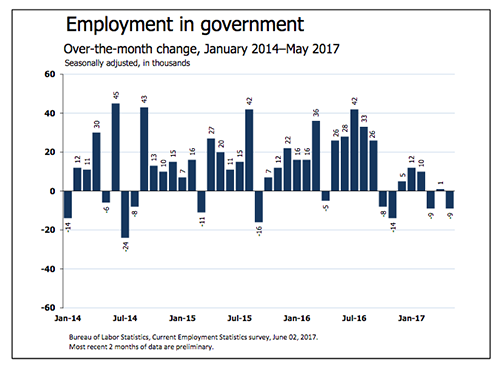
In Catholic theology, purgatory or limbo describes an after-death location that is somewhere between heaven and hell. While the state of affairs for federal workers certainly isn’t that dire, it’s increasingly evident that advancement and even continuing employment may upcoming challenges that face many who had planned a government career. Here’s an update of the current situation and some advice for government execs and managers who may be considering a move to the private sector.
The Trump administration’s hiring freeze officially ended on April 12, but there’s been no great resurgence of new federal jobs. One set of Bureau of Labor Statistics (BLS) figures shows employment up a fraction of a percent between February and May1. Another report shows negative numbers since the beginning of the year.2

The nearly non-existent response to the lifting of the hiring ban has led some to ask if a de facto hiring suspension is still in place. It is, at least in a certain sense. The memorandum that accompanied Office of Management and Budget (OMB) Director Mick Mulvaney’s April announcement called for OMB-directed agencies to make immediate plans to reduce workforce size and to submit proposals with details of long-term strategies for employee cuts by June 30.3
Also influencing the semi-frozen state of federal hiring was the President’s March budget blueprint, which set a clear priority for reducing the size of government. That was followed May 23 by a full budget proposal with “reduction of the federal civilian workforce” stated as a goal in the summary section of the document.
In an interesting article in his ChiefHRO blog, Jeff Neal points out a major difference between the aftermath of this hiring freeze and others that have come before:
Those freezes differed from today, because agency heads typically wanted to staff up their agencies. With this administration, there are many agency heads who are more interested in reducing the size of their workforce. Couple that with a 2018 budget proposal that called for massive cuts in some agencies, and the result is something we might term as a hiring slush. It isn’t quite frozen, but it isn’t quite thawed.4
Separation incentives or buyouts are part of the toolset that agencies can use to encourage employees to depart. The Office of Personnel Management (OPM) must approve requests from agencies to use Voluntary Early Retirement Authority (VERA) or Voluntary Separation Incentive Payments (VSIP). As of the writing of this article, no agencies have applied to OPM for authority, but there are indications that plans for buyouts are in the works.
The State Department is reportedly looking to eliminate up to 600 positions through buyouts. The Interior Department may eliminate more than 6 percent of their workforce (4,000 employees) in fiscal year 2018. The Environmental Protection Agency has already begun to hold informational meetings with employees at regional offices.5
Other agency plans are somewhat surprising. The Veterans Administration, badly in need of medical employees, announced that they would not fill 4000 positions. Even the Defense Department, likely to see a budget increase has eased on the brakes. A May 2 memo from Deputy Secretary of Defense Robert Work lifted the freeze, but placed additional restrictions on DoD hiring.6

Uncertain prospects for a fiscal year 2018 budget certainly aren’t boosting the prospects for renewed federal hiring. The short story is that even Congress doesn’t know whether there will be a budget or what departments might receive cuts or increases. The May 1 spending bill increased military spending, but also maintained and slightly increased domestic program expenditures for the remainder of the 2017 fiscal year that ends September 30.
In 2017, President Obama’s last budget proposal was ignored in Congress. Neither the House nor the Senate budget committees held hearings. Theoretically, President Trump’s initial budget should receive a better reception with Republicans in control of both houses of Congress, but there are significant differences in priority between the administration and the congressional leadership.
Prospects for a budget bill by September 30 seem remote. It appears very likely that there will be another continuing resolution and there is a possibility of a government shutdown in October.
If federal government woes have your career in limbo, should you consider a move to the private sector? If you’re a career federal employee, the notion of a career change may have crossed your mind. Despite the near certainty of a shrinking federal workforce, government jobs aren’t going away and there will continue to be federal career opportunities. To mix metaphors, it’s probably best to make sure that the grass is greener on the other side before jumping the purgatory fence. Plot your strategy well and don’t move too quickly.
That said, now could be a good time to start looking, especially if you feel that your federal career prospects are dimming. The economy is growing, but the process of finding the right career move is likely to take several months. Competition from other federal employees may increase as cuts and buyouts are announced. It’s almost always better to look for your next position while you’re still employed. You’ll want to have time to thoroughly evaluate opportunities and negotiate from a position of strength.
If you begin your job search now, you’ll also be in a stronger position to make a decision if you are offered a buyout. Currently, the authorized amount is only $25,000 ($40,000 for DoD). If you’re well ahead with your job search, you may be able to transition quickly and keep that award as a departure bonus. Again, move carefully. $25,000 doesn’t go as far as it once did. If you do accept a VSIP, you’ll have to pay the money back if you return to the federal government payroll within 5 years.
Even if the private sector isn’t paradise, starting the process of transition from government employment to the private sector could be a good plan for your career. A great way to begin your search for a private sector job is with a call to CareerPro Global. We offer an array of valuable services to help with your transition to the private sector, including coaching to help you make the decisions that will move your career forward.
We can also help you translate your career accomplishments and your capabilities into language that will resonate with private sector recruiters and decision makers. Your management resume will showcase your expertise, your areas of specialty, and provide examples that illustrate your leadership and practical skills. An executive resume will stand out from the competition and immediately establish your personal brand.
For almost four decades, the Master Resume Writers at CareerPro Global have helped job seekers in both government and the private sector with resumes and career coaching that leads to higher response rates, more interviews, and rewarding careers. If you’re considering your next career move, we hope you’ll get in touch to schedule a free career consultation.
Sources:
1 US Department of Labor, Bureau of Labor Statistics, Economic News Release, Table B-1. Employees on nonfarm payrolls by industry sector and selected industry detail.
2 US Bureau of Labor Statistics, Current Employment Statistics Highlights, p. 17, 6/2/17
3 Office of Management and Budget, Memorandum: Comprehensive Plan for Reforming the Federal Government and Reducing the Federal Civilian Workforce, April 12, 2017.
4 Neal, Jeff, Is There Still A Hiring Freeze?, ChiefHRO.com, May 10, 2017.
5 Katz, Eric. OPM is Ready, but No Agencies Have Requested Separation Incentive Authority Yet, Government Executive, May 8, 2017.
6 US Department of Defense Memorandum, May 2, 2017.